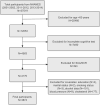Association between the serum uric acid/serum creatinine ratio and cognitive function in older adults: NHANES in the United States
- PMID: 39009809
- PMCID: PMC11251062
- DOI: 10.1038/s41598-024-67580-y
Association between the serum uric acid/serum creatinine ratio and cognitive function in older adults: NHANES in the United States
Abstract
Cognitive impairment can potentially become a significant health concern in older adults. However, early effective diagnostic methods are still lacking. Therefore, we utilized the NHANES database in the US to investigate the relationship between serum uric acid to serum creatinine (SUA/SCR) ratio and cognitive impairment. In our study, a total of 3874 participants were included (2001-2002, 2011-2014). Weighted t tests or chi-square tests were utilized to analyze the basic characteristics of the population. Weighted logistic regression analysis, smooth-fit curves, threshold effects, and subgroup analysis were conducted to investigate the correlation between the SUA/SCR and cognitive impairment. In this study, the SUA/SCR was significantly lower in individuals with cognitive impairment. The logistic regression model, after adjusting for all covariates, revealed that the Q2-Q4 were 0.65 (95% CI 0.49, 0.86), 0.60 (95% CI 0.40, 0.90), 0.55 (95% CI 0.39, 0.77) respectively. This indicates that participants in the Q4 had a 45% reduced risk of cognitive impairment. Smooth-fit curves and threshold effect analysis revealed a nonlinear relationship between SUA/SCR and cognitive impairment, with a turning point at 4.13. Subgroup analysis showed no statistically significant differences in the relationship between SUA/SCR and cognitive impairment among different subgroups (P > 0.05). Our findings indicate a negative correlation between the SUA/SCR and the risk of cognitive impairment in the population of adults aged 60 and above in the US. This suggests that the SUA/SCR holds promise as a potential indicator for cognitive impairment.
Keywords: Cognitive impairment; SUA/SCR ratio; Serum creatinine; Serum uric acid.
© 2024. The Author(s).
Conflict of interest statement
The authors declare no competing interests.
Figures



Similar articles
-
Correlation between serum uric acid to serum creatinine ratio and infertility in reproductive-age female of American: data from national health and nutrition examination survey (NHANES), 2013-2016.J Gynecol Obstet Hum Reprod. 2025 Jun;54(6):102965. doi: 10.1016/j.jogoh.2025.102965. Epub 2025 Apr 30. J Gynecol Obstet Hum Reprod. 2025. PMID: 40316172
-
Effect of serum uric acid to creatinine ratio on cognitive function decline in middle-aged adults: Longitudinal evidence from CHARLS.J Alzheimers Dis. 2025 Jan;103(2):582-592. doi: 10.1177/13872877241303789. Epub 2025 Jan 10. J Alzheimers Dis. 2025. PMID: 39791192
-
Association between serum uric acid to serum creatinine ratio with cardiovascular and all-cause mortality in adults with hypertension.Sci Rep. 2024 Aug 3;14(1):18008. doi: 10.1038/s41598-024-69057-4. Sci Rep. 2024. PMID: 39097647 Free PMC article.
-
Association between serum uric acid-to-creatinine ratio and non-alcoholic fatty liver disease: a cross-sectional study in Chinese non-obese people with a normal range of low-density lipoprotein cholesterol.BMC Gastroenterol. 2022 Sep 14;22(1):419. doi: 10.1186/s12876-022-02500-w. BMC Gastroenterol. 2022. PMID: 36104672 Free PMC article.
-
Association between serum uric acid/serum creatinine ratios and lung function in the general American population: National Health and Nutrition Examination Survey (NHANES), 2007-2012.BMJ Open Respir Res. 2023 Mar;10(1):e001513. doi: 10.1136/bmjresp-2022-001513. BMJ Open Respir Res. 2023. PMID: 36882222 Free PMC article.
Cited by
-
Serum uric acid to creatinine ratio in patients with early-onset post-stroke cognitive impairment: a retrospective cohort study.Front Aging Neurosci. 2025 Jul 2;17:1580722. doi: 10.3389/fnagi.2025.1580722. eCollection 2025. Front Aging Neurosci. 2025. PMID: 40671786 Free PMC article.
References
MeSH terms
Substances
LinkOut - more resources
Full Text Sources
Medical

